Key Insights
- TRON network activity reached a refreshed foundational user base after the launch of USDD in May.
- Since May, the total amounts of stake and engaged stake have increased drastically.
- The 61% growth in TVL was driven by three unique wallets depositing approximately $1.6 billion in various assets.
- The TRON DAO Reserve announced the crypto-native market maker Wintermute as its ninth whitelisted member, giving it the authority to maintain the peg of USDD.
- The GreatVoyage-V4.5.2 upgrade released in Q3 aims to improve node synchronization and transaction throughput.
- If current activity persists and USDD expands across the ecosystem, TRON’s Resource Model that catalyzes deflation may be enhanced by using USDD.
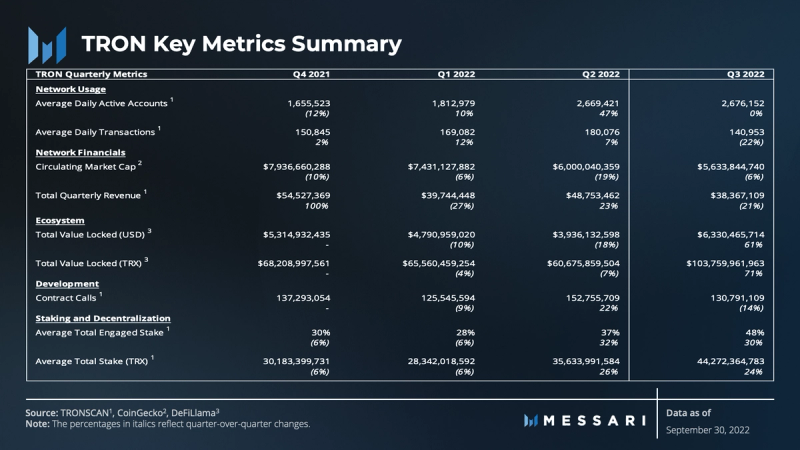
Primer on TRON
TRON is a public open-sourced blockchain network using a Delegated-Proof-of-Stake (DPoS) mechanism and the Practical Byzantine Fault Tolerance (PBFT) consensus algorithm. TRON uses DPoS to introduce an election mechanism to determine who maintains the network. An election occurs every six hours, resulting in 27 Super Representatives who take turns producing blocks.
The TRON Virtual Machine (TVM) powers applications on the network and uses “Energy & Bandwidth” instead of gas, like its Ethereum Virtual Machine (EVM) counterpart. The TVM is EVM-compatible and effectively offers developers more affordable smart contract execution.
As the first edition of the quarterly coverage of TRON, this report will highlight key concepts and the network’s most recent quarterly developments and performance.
Performance Analysis
Network and Financial Overview

User activity, measured by daily active accounts, was flat (0.3%) QoQ, while newly activated accounts decreased by 21.7%. Both percentage changes indicate that a foundational level of existing accounts continued to use the network while new entrants slowed during the quarter.
The foundational user base became more active, as seen in the total average daily transactions and transactions per second (TPS) increasing.
Revenue and average transaction fees continued to decrease in Q3. The metrics are interconnected since transaction fees generate revenue. However, revenue did not decline as much as transaction fees. Based on this relationship, the increase in daily transactions propped up revenue.
Staking yield declined because the total stake increased, which is a sign of healthy network participation. The changes were unrelated to total rewards, which were relatively stable.
Market cap (i.e., network value) also declined with transaction fees and revenue, albeit by less.
The relationship between each measure reveals more about the network’s fundamentals. In particular, each metric is connected by TRON’s Resource Model in some way. The Resource Model aims to lower transaction fees and regulate network demand through transaction fees. Moreover, revenue is generated and burned when transaction fees are applied, thereby removing TRX from the network’s circulating supply. By increasing scarcity, value is created for all tokenholders rather than just compounding the balances of validators and delegators.
Ultimately, the Resource Model allows for free transactions when users use the network within their means. On the other hand, when users demand more transactional power than what is available in acquired resources, they incur transaction fees. Collectively, this keeps transactions low on average but puts the protocol in a position to generate revenue when the demand is high from specific users. With greater demand, supply is burned, thereby putting upward pressure on the network value.
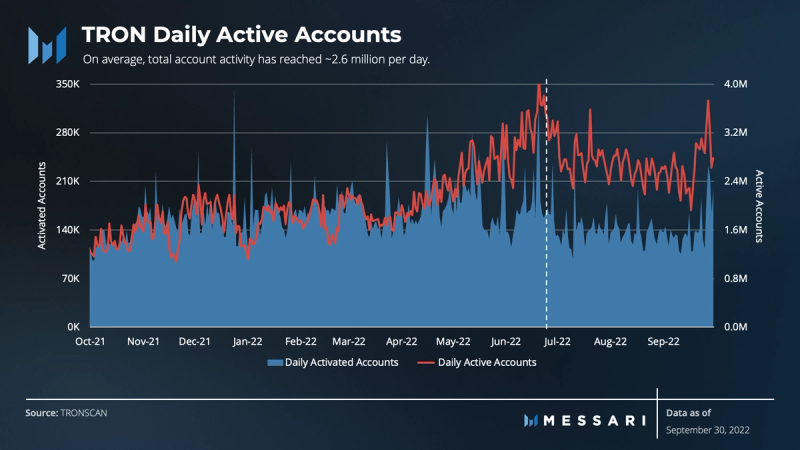
The Resource Model employs what is called Bandwidth Points and Energy. A total of 1,500 Bandwidth Points are distributed for free to all activated accounts every 24 hours. They are also earned by staking TRX. Bandwidth allows users to perform transactions on the TRON network without paying transaction fees. If users do not have sufficient Bandwidth, a transaction fee of 0.001 TRX is applied and burned.
Newly activated accounts combined with the Resource Model are critical to the value accrual of TRX and network value. Newly activated accounts do not necessarily exist on-chain. They need to be activated before they can be found. To activate, accounts must:
- Send any amount of TRX or TRC-10 tokens from an existing account to a new account.
- Call Java-tron’s API to create a transaction from an existing account, sign it, and broadcast it to the TRON network.
- Pay an account creation fee of 1 TRX.
Transferring tokens requires Bandwidth Points. Transaction fees are generated and burned to the extent that a newly activated account does not attain enough Bandwidth Points.
Transferring TRX or TRC-10 tokens to an inactive account can also complete account activation. This route does not require the 1 TRX account creation fee or Bandwidth. Instead, a resource called Energy is needed. Like Bandwidth, Energy can be acquired by staking TRX, but Energy is not distributed to every account for free. Energy represents how much CPU resources are consumed during an execution of a smart contract. Similarly, when a user consumes more Energy than owned, a transaction fee occurs and is burned.
With that in mind, the usefulness of TRON, whether it be from the use of DeFi, stablecoins, or any other use that the network offers, will determine the rate at which new accounts are activated. In turn, its utility will drive value to the network.
The daily active accounts metric consists of new and existing account activity. Daily active accounts and newly activated accounts reversed course at the end of Q2.
On average, total account activity seems to have settled down to ~2.6 million per day. The daily average of 2.6 million over Q3 was not based on an uptrend or bursts of usage as in Q2. Q3 daily activity was relatively more stable. The activity in Q2 was a period of high growth primarily supported by the burst in May, after the launch of USDD, TRON’s decentralized, overcollateralized stablecoin.
Further, the average daily active accounts during the twelve months leading up to Q3 was ~2 million per day. Therefore, the Q3 average represents a 30% increase over the longer-term average. The longer-term growth rate, paired with sideways usage during Q3, may indicate a sustainable base of daily active users.
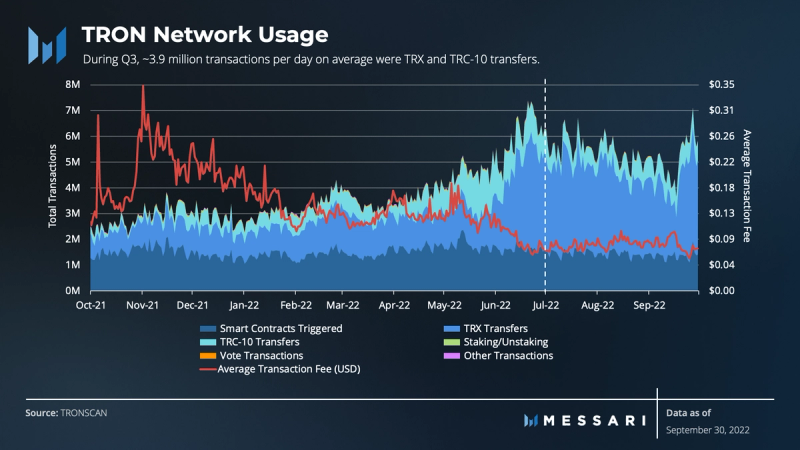
On the TRON network, every interaction counts as a transaction. Token transfers are transactions broken down by their corresponding token standards, such as TRX, TRC-10, TRC-20, and TRC-271. A transaction also occurs when a user stakes or unstakes their TRX tokens or when a smart contract is called or deployed. By staking tokens, users can vote on Super Representative candidates (i.e., validators), which also counts as a transaction.
Since activating an account requires at least one transfer, a portion of transfer activity results from account activation. During Q3, ~3.9 million transactions per day on average were TRX and TRC-10 transfers. This amount represents about 73% of total transactions on the network. Given the average number of activated accounts of 140,000 per day, about 3% of token transfers came from account activations. Existing users generated the other 97%.
Overall, total transactions grew by 12.4% to 5.3 million over Q3. Most of the growth can be attributed to the 62% increase in TRX transfers. Over the last two quarters, TRX transfers have dominated transaction activity.
Smart contract triggers were down ~14%, indicating a reduction in application users. Transaction activity declined for many of TRON’s DeFi protocols, coinciding with fewer triggered smart contracts. However, the use of USD Tether (USDT) remains the primary use and driver of smart contract execution on TRON. While USDT activity was down QoQ, it was likely because there was an uptick in transfers in Q2 when USDD launched. Nonetheless, TRON hosts the largest circulating supply of USDT. For perspective, smart contract triggers make up 26% of total transactions. USDT contract calls consume about 75% of Energy consumption and ~90% of all contract calls. Therefore, USDT smart contracts usage drives the majority of Energy consumption and revenue with the shortage of Energy.
In sum, TRX and TRC-10 transfers and smart contract transactions primarily from USDT make up ~99% of the transaction activity on the network. Transacting with each requires Bandwidth and Energy. Over the last several quarters, users have consumed more of these resources than they accrue. While resources are still being acquired, which incentivizes staking participation and keeps fees low, the demand for these transactions outweighs the resources. The result is continued revenue generation and a deflationary TRX.
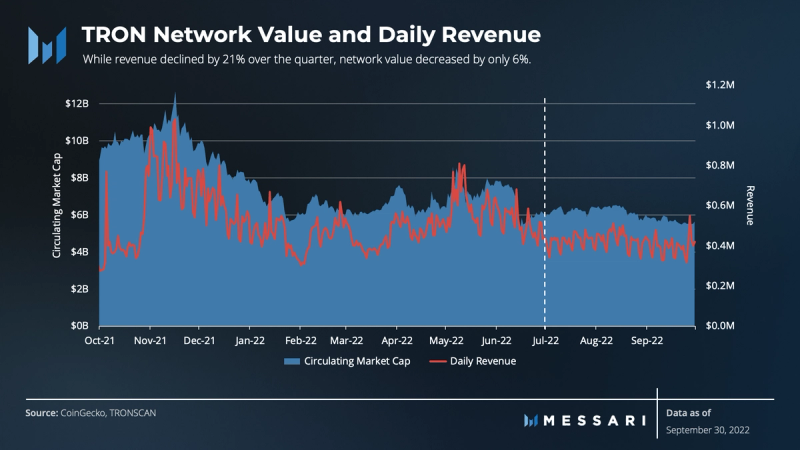
A foundation of users and transaction activity would drive reliable revenue and value accrual to the network. Even so, it is difficult to determine the exact nature of the relationship between revenue and network value. Is network value driven predominantly by more users and transactions or higher transaction fees? Or is it driven by a deflationary mechanism? Ideally, more users and transactions, albeit with lower transaction fees, would drive revenue upwards and represent fundamental value accrual. This situation would be more sustainable than value coming from revenue driven by higher transaction fees or speculative value.
To that end, TRON’s revenue and network value continue to be correlated, as the volatility and daily revenue trends are generally accompanied by movements in network value.
However, while revenue declined by 21% over the quarter, partly due to a decline in average transaction fees (-33%), the network value decreased by only 6%. For perspective, the circulating market cap was 123 times the total quarterly revenue at the end of Q2 compared to 146 times at the end of Q3. Dividing valuation by revenue reveals how much a unit of the native token is worth per unit of revenue. On a relative basis, TRX is now more expensive per unit of revenue compared to last quarter.
With that in mind, part of the support in value may have come from USDD. The launch of USDD in Q2 introduced another deflationary mechanism to the TRON ecosystem. It may draw in more foundational users and transaction activity that consumes more Bandwidth and Energy. The launch may also be a growth catalyst that, in itself, puts downward pressure on the circulating supply of TRX as it expands across the TRON ecosystem and beyond.
Ecosystem & Development Overview
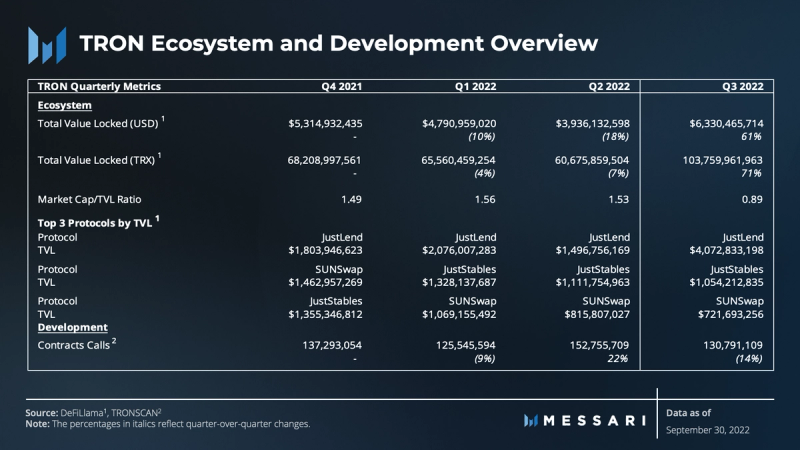
Decentralized Finance (DeFi)
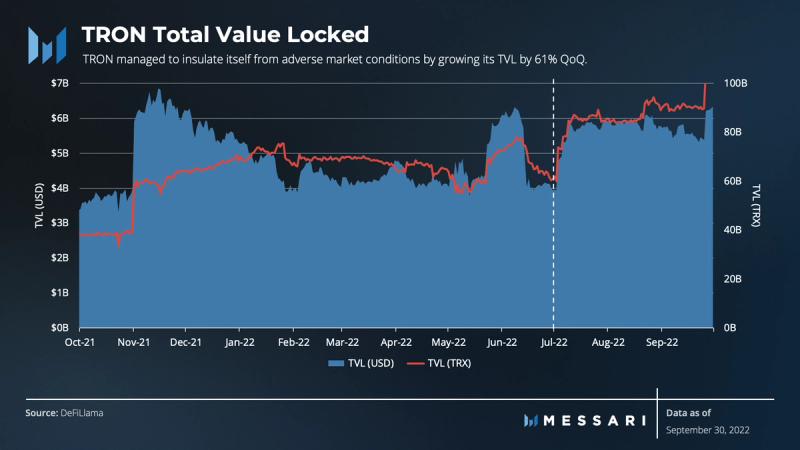
The majority of Layer-1 blockchains and their respective ecosystems have experienced declines in the first half of 2022. For most, Total Value Locked (TVL) declined further in Q3, due to a continuation in negative market sentiment and looming regulatory concerns. TRON, however, managed to insulate itself from adverse market conditions by growing its TVL by 61% QoQ.
TRON’s ecosystem and respective TVL is concentrated among three DeFi protocols, accounting for over 90% of the market share. Any ecosystem with this much concentration would inherently expose its value to the risk of an exploit.
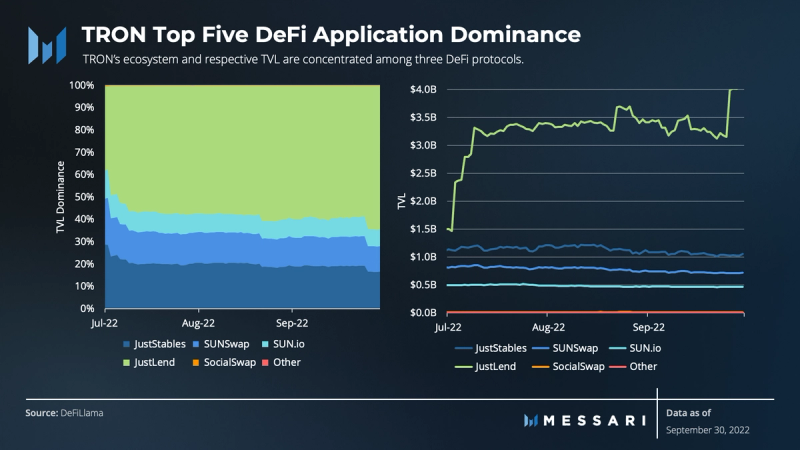
JustLend, the most dominant protocol in terms of TVL (64%), is TRON’s flagship money market protocol. It allows users to supply liquidity in exchange for yield and also allows users to deposit qualified collateral and borrow against it. JustLend was the driving force behind the isolated growth (172%) QoQ, as it accumulated $2.5 billion in TVL by the end of Q3.
In the first half of Q3, TRON’s TVL ballooned, which was a result of assets getting deposited into JustLend. Looking further, on-chain data showed three unique wallets depositing approximately $1.6 billion in various assets like Bitcoin, USDC, and USDT. This activity demonstrates that three whales were the primary contributors to the growth in TVL in Q3.
Three unique wallets comprising of ~$1.6 billion in deposits:
- Wallet 1 – 20,000 BTC and 21,000 BTC
- Wallet 2 – 90 million USDC and 140 million USDT
- Wallet 3 – 76 million USDC and 445 million USDC
TRON’s other DeFi protocols like SunSwap and JustStables were down for the quarter, consistent with the broader market.
TRON launched its overcollateralized hybrid-model stablecoin, USDD, in Q2. USDD is pegged 1:1 against the U.S. dollar, and users can swap between other stablecoins at a 1:1 ratio without any slippage using the Peg Stability Module, introduced in August. USDD is backed by approximately ~$38 billion in various fiat-backed stablecoins held in the TRON DAO Reserve.
USDD distinguishes itself from other stablecoins by exceeding the common 120% collateral ratio. Additionally, users can burn their USDD to mint a $1 worth of TRX in the event of a short-term depegging of USDD.
Staking and Decentralization Overview
The security of PoS and PoS derivation networks like TRON requires users to lock up (stake) the network’s native tokens and participate in validation duties. A distributed network of validators, active participants, and stake can help ensure the network functions as intended.
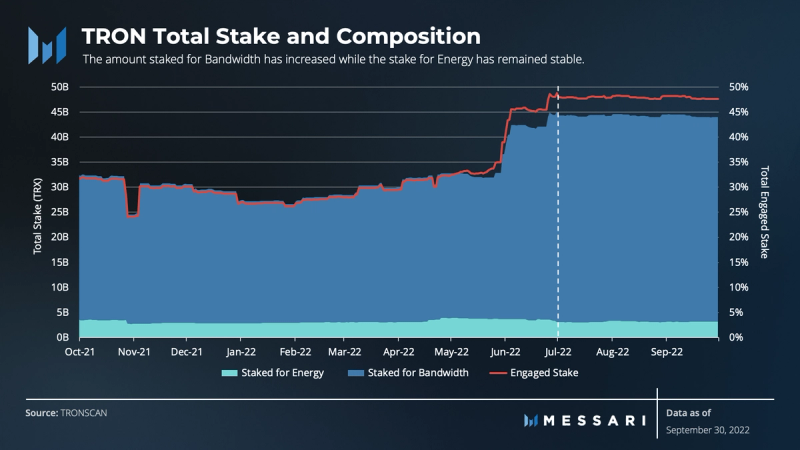
As mentioned, the Resource Model is based on distributing Bandwidth and Energy to stakers. The stakers can then use those resources to transact and execute smart contracts for free so long as they have acquired enough resources. If users utilize more computing power than their resources, they must cover transaction fees. Since May, the total amounts of stake and engaged stake (total stake divided by total supply) have increased drastically. Interestingly, the amount staked for Bandwidth increased while the stake for energy remained stable.
Nonetheless, this increase may indicate demand for Bandwidth. Further, a higher engaged stake also represents frozen assets and contributes to the stability of network value. The more staked and stable the engaged stake is, the more stability can be found in TRX and the value of the network.
In addition to obtaining Bandwidth or Energy, users that stake TRX will also get voting rights simultaneously.
TRON utilizes a Delegated-Proof-of-Stake (DPoS) mechanism to aid in consensus and validating blocks. Block validation is done by an elected group of validators called Super Representatives (SRs). All TRX holders can apply to be SR candidates. Any TRX holder can vote for SR candidates, among which the top 27 most-voted candidates will become SRs for the next epoch, while the 28th to 127th will become SR Partners.
SRs are responsible for producing blocks and packing transactions, but only SR Partners receive voting rewards without performing the aforementioned two tasks. All SR candidates, SR Partners, and SRs have the right to make proposals to modify parameters on the TRON network.
At the end of Q3, there were over 350 SR candidates voting for 27 SRs in each epoch. The following is an example of votes aimed at a set of SR candidates elected for block production.
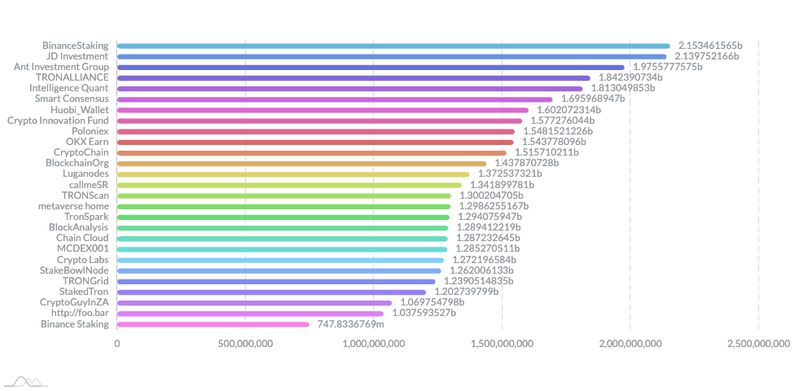
Source: TRONSCAN
The election mechanism works such that 1 TRX equals one vote. Voting for candidates is a single transaction where any staker can vote by generating a voting transaction.
During each Epoch, which occurs every six hours, the 27 SRs take turns generating blocks according to a bookkeeping order. With this approach, a voted-for, single-file line to block production creates the blockchain.
TRON utilizes an incentive model to encourage node participation and network expansion to ensure operation. SRs who complete block production tasks are rewarded with TRX. The model also specifies that SRs receive 16 TRX for every confirmed block they produce. With each block’s production, the TRON network will also reward 160 TRX to SRs and SR Partners who will share 160 TRX in proportion to the votes they get from the community. Any account can apply to become a Super Representative candidate by paying 9,999 TRX ($610 as of 9/30) to join the SR election.
A growing number of SR candidates will continue to challenge the voting population to narrow down the 27 SRs.
Qualitative Analysis
Catalysts and Strategies for Ecosystem Growth
Aside from the key concepts and fundamentals that incentivize new users and activity to the ecosystem and network, other aspects of the TRON strategy have been running in the background. While not mutually exclusive, network upgrades, partnerships, and deployments have been strategic elements driving TRON network adoption.
Network Upgrade
GreatVoyage-V4.5.2 (Aurelius) – The non-mandatory release implements upgrades from three TRON Improvement Proposals (TIP).
- TIP-425 shortens the TCP connection establishment time, which aims to speed up node synchronization and reduce the block loss rate.
- TIP-428 improves transactions per second and reduces the block loss rate by reducing the transaction ordering mechanism.
- TIP-440 introduces Bloom Filters, a space-efficient probabilistic data structure, to optimize the transaction cache by reducing memory usage.
Partnerships and Deployments
Wintermute
In August, TRON announced Wintermute as the ninth whitelisted institution of the TRON DAO Reserve (TDR), which governs the overcollateralization of USDD. Wintermute is one of the largest crypto trading firms in the space and is an experienced market maker. The other TDR institutions are Alameda Research, Amber, Ankr, FalconX, Poloniex, Mirana, Multichain, and TPS Capital. These members are responsible for actively monitoring the stability of USDD and have the right to mint and burn USDD.
JustLend
A strategic partnership between the TRON DAO Reserve and JustLend was formed at the beginning of Q3. JustLend will distribute supply mining rewards denominated in USDD to protocol users. In addition, the recipients can use the USDD to mine additional rewards on the Sun.io protocol.
Creditcoin
The partnership will introduce a TRON Gateway, which facilitates token bridging between Ethereum and TRON, in addition to BNB Smart Chain and Bittorrent Chain. This will improve cross-chain accessibility and utility for users.
Strategy and Challenges
TRON DAO Initiatives
The TRON DAO is focused on growing its ecosystem by onboarding more participants to the network. The TRON DAO Grants Program aims to allocate from $30,000 to $90,000 each quarter to eligible community members, developers, and influencers who meet the grant’s criteria. These programs are designed to attract members and developers to build and contribute to TRON’s ecosystem.
In addition, the TRON DAO launched a series of TRON Grand Hackathons in 2022. There were 118 participants with a total bounty of $500,000 across four tracks (e.g., GameFi, DeFi, NFT, and Web3) in its first iteration. The second hackathon amassed over 1,800 participants, doubling the bounty to $1 million.
Select members from the TRON DAO Reserve and other crypto institutions are chosen to judge which applications would help accelerate the TRON ecosystem.
Challenges
Despite being one of the top Layer-1 protocols, the ecosystem lacks diversity compared to some of its peers, as it is largely concentrated across a few protocols. Although TVL skyrocketed in the quarter, it was predominantly due to a few whale wallets.
The high concentration of TVL in three protocols and a few wallets could be a concern for the sustainability of TRON’s current DeFi landscape. Three wallets deposited approximately $1.6 billion in Q3, representing roughly a quarter of its total TVL. Should any of these wallets decide to withdraw their funds, the considerable impact on TVL could negatively affect TRON’s ecosystem and user base.
The Road Ahead
In Q3, TRON announced its support to collaborate with MasterBlox and WeFund to focus on increasing the adoption of Web3 and growing its ecosystem. Through joint acceleration and incubation programs, the collaboration aims to be a launchpad and provide tools for communities and developers to build on the network.
TRON doesn’t currently feature an official roadmap; however, some of its documentation suggests the ecosystem’s original 10-year roadmap has three key integrations on the horizon: Apollo, Star Trek, and Eternity. TRON continues to build onto the current Great Voyage network implementation and, with time, will work towards the three implementations.
Closing Summary
During Q3, daily active accounts were flat QoQ, while newly activated accounts decreased. However, the stabilization of existing account activity came on the heels of the launch of USDD in May. Since May, the existing user base has become more active as total average daily transactions and transactions per second (TPS) increased. Further, the total amount of stake increased drastically, as has the total engaged stake.
If the current activity level persists and USDD expands across the ecosystem, TRON’s Resource Model, which catalyzes deflation with greater demand, may be enhanced by the demand for and use of USDD. Further, USDD itself introduced another deflationary mechanism to the TRON ecosystem. Collectively, the combination could put upward pressure on revenue from resource depletion. It could also put downward pressure on the circulating supply of TRX in the event of burning TRX to mint USDD.
Aside from these key concepts and fundamentals, other aspects of the TRON strategy to grow have been in motion. The TRON DAO Reserve announced the crypto-native market maker Wintermute, giving it the authority to maintain the peg of USDD. A strategic partnership between the TRON DAO Reserve and JustLend was formed to distribute supply mining rewards denominated in USDD to protocol users.
The high concentration of TVL in three protocols and the three unique wallets depositing $1.6 billion is a concern for the sustainability of TRON’s current ecosystem. The TRON network will only mitigate this risk by executing its plans to roll out network upgrades, form partnerships, and deploy more uses like USDD.
Let us know what you loved about the report, what may be missing, or share any other feedback by filling out this short form.
Looking to dive deeper? Subscribe to Messari Pro. Messari Pro memberships provide access to daily crypto news and insights, exclusive long-form daily research, advanced screener, charting & watchlist features, and access to curated sets of charts and metrics. Learn more at messari.io/pro.
This report was commissioned by Tron Network Ltd, a member of Protocol Services. All content was produced independently by the author(s) and does not necessarily reflect the opinions of Messari, Inc. or the organization that requested the report. Paid membership in Protocol Services does not influence editorial decisions or content. Author(s) may hold cryptocurrencies named in this report. Crypto projects can commission independent research through Protocol Services. For more details or to join the program, contact ps@messari.io. This report is meant for informational purposes only. It is not meant to serve as investment advice. You should conduct your own research, and consult an independent financial, tax, or legal advisor before making any investment decisions. The past performance of any asset is not indicative of future results. Please see our terms of use for more information.
















